Some insects sting, others bite, but they rarely do both. Bees are famed for their stingers, but research shows that they can also bite. Amazingly, they have mouth parts that are adapted both to suck and chew.
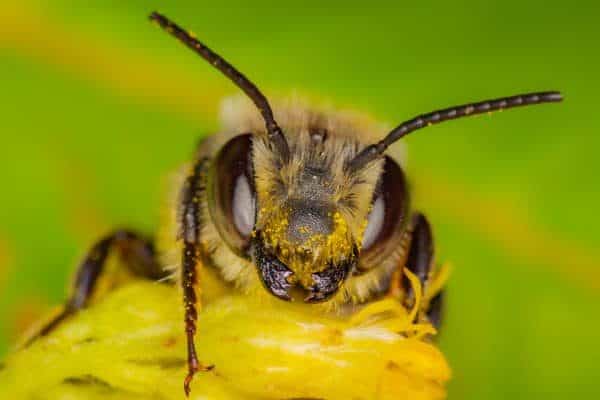
When we think of teeth, we relate to the hard, enamel-coated structures that we use for biting and chewing. It is quite odd to think of bees having teeth, but the truth is these small -excellent creatures are perfectly adapted to their environment.
Do bees have teeth? Bees have toothed edges on their mandibles. The number and size of the teeth vary between bee species. Some have simple mandibles with few teeth, while others have many that are sharply pointed or rounded. The toothed mandibles are used in and out of the hive for grasping or cutting.
There is more to the bees’ mandibles than meets the eye. Do all bees have toothed mandibles? Can bees bite you? Stick with me as we delve deeper into this topic.
The Bee’s Mandibles
As aforementioned, bees have toothed mandibles that can open and close to bite, chew, manipulate wax, clean the hive, and so on. The pincer-like extensions are located on the sides of the bee’s mouth at the ends of the labrum (upper lip). Like many other insects, the movable mandibles (jaws) swing in and out. This movement is enhanced by two powerful muscles known as abductors and adductors.
Do All Bees Have Teeth?
The worker bee, queen, and drone have mandibles, although they differ in shape and size. In a worker bee, mandibles play a vital role in her life. They are involved in all the duties she performs. Surprisingly, a honey bee worker uses her mandibles before using her sting or wings!
To get a way out of the cell where she evolved from a fertilized egg, she chews her way out. Once out, she goes back to the brood cell to clean up the debris and polish the surfaces for the next bee.
A queen uses the mandibles to cut through the dense layers of wax, after maturation from egg to queen. Although a queen lacks other working features possessed by a worker bee such as wax secreting glands, pollen sacs, and the like, she has sharp cutting teeth. The queen is covered with more layers of wax than the worker bee.
Once she is out of her queen cell, she uses her teeth to destroy other virgin queens that are in their brood cells, by cutting open the side of their cells and stinging them. She makes sure she eliminates all other virgin queens to remain alone in a hive or a nest.
Drones have mandibles, but they are too small meaning they need assistance to break through their brood cells.
Can a Bee Bite You?
Most of us know the painful sting of a bee, but we are unaware of its numbing bite. A bee can bite you, but this depends on their teeth and level of aggression. The more aggressive a bee species is, the more painful is its bite. For example, Bumblebees have soft mandibles, and their bite is so soft that you will not even feel it.
A bite from Trigona hyalinata, a stingless bee, can be painful due to its persistence and its 10- teeth arranged on its mandibles. Although a bite from a Trigona bee is less painful than a sting from a honey bee, it can cause unpleasant pain, especially on a sensitive part of the skin. Amazingly a Trigona bee can persist on biting for more than an hour.
A study was carried out on stingless bees in Brazil, where small flags were waved at the entrance of a colony to provoke the bees. The time the bees took to attack the flags was then taken, and it was discovered that some of the bees attacked the flags for over an hour.
Honey bees can also bite, injecting a dose of 2- heptanone from their glands. Research shows that the 2-heptanone secreted from the mandibular glands when a bee bites can act as a local anesthetic on a mammal’s peripheral nervous system.
The low-toxic anesthetic can also be used in humans with tests suggesting it can be as effective as the famous lidocaine, a numbing medication. This natural anesthesia can be an ideal replacement for the local anesthetic to which some people may be allergic.
How Do Bees Use Their Toothed Mandibles?
Just like the jaws in animals, bees use their mandibles to bite and chew. Other uses include cutting, tearing, grasping, and crushing. Unknown to many people, the bee’s mandibles are in constant use in a bee’s life. Here are some of the purposes of the mandibles.
1.Feeding The Young
One of the duties of a young worker bee is to feed the larvae. Their mandibles act as a spoon for feeding the young ones in the colony.
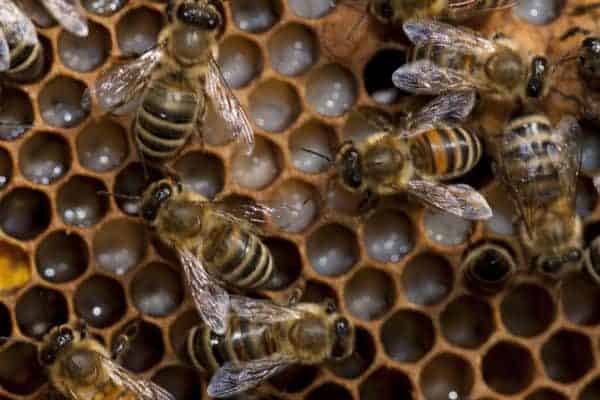
2. Comb Building
Comb building starts when young worker bee’s secret wax from their wax glands situated underneath their abdomen. The wax quickly hardens after secretion into small discs. The bees collect these discs by piercing them with spines on their legs and moving them to the mandibles where they are chewed into a supple form.
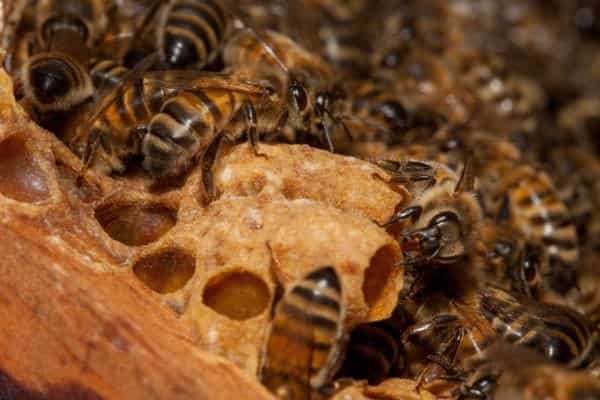
This process is enhanced by enzymes from their salivary glands. She then uses the teeth to cut the soft wax, form, and polish each cell. It is quite amazing how she builds the uniform interlocking hexagon structures.
3. Manipulating Flower Parts And Carrying Building Materials
Honey bees can use their mandibles to release pollen from the flowers and also to collect nectar. Some bee species like the Bombus lucorum have shorter tongues that cannot reach the nectar. How do they collect nectar? They bite the bottom of a flower and suck the nectar out, an extraction method known as “nectar robbing”. The problem with this method is that a bee does not pollinate a flower.
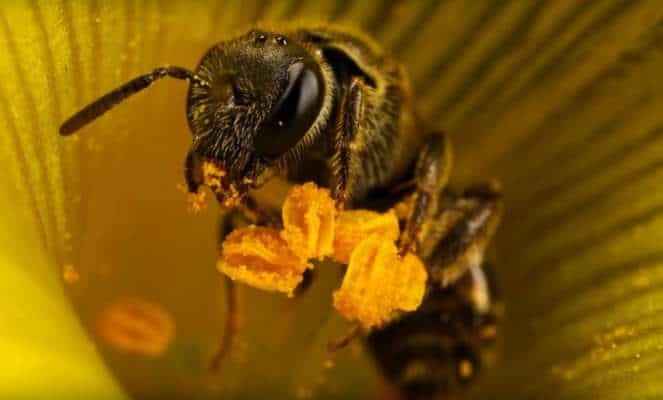
Leafcutter bees use their toothed mandibles to cut pieces of leaves for their nests. Surprisingly, a bee sits on the piece of the leaf it is cutting, while wrapping its legs around it. At the last cut, it takes off with the leaf piece, rolled like a carpet to minimize wind resistance as they fly back to the nest. They also use the mandibles to carry the building materials to their nests.
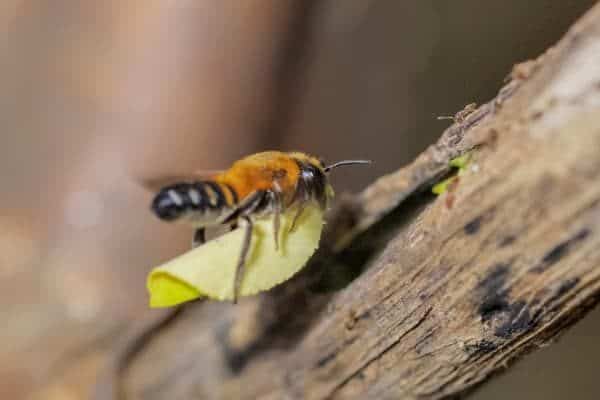
Some bee species excavate into the mud or wood while building nests. Bees of the Megachilidae family have large toothed jaws which they use to collect building materials such as sand, fibers, petals, pebbles, and even mud. These are ferried to their homes by the mandibles.
Giant resin bee (Megachile pluto) tears tree barks using her jaws to release and collect resin from wounds. Carpenter bees use their mandibles to drill cavities into the wood, which are their nesting chambers.
4. Mark A Territory
When a male bumblebee wants to mark a territory, he flies around it in circles. Occasionally, he stops and lodges on a plant, and opens and closes his mandibles repeatedly. This process releases a scent from the mandibular glands, which marks an area he is claiming.
5. To Fight Predators
Stingless bees use their teeth as a primary weapon of defense. Trigona hyalinata, a stingless bee, has painful and persistent bites. Their main threats are ants and other bees, and biting is an effective way of driving them off. They still use this fighting mechanism on larger intruders.
Fire bees secret formic acid from their mandibular glands, and when the bite spittle some formic acid on the wound to make sure a predator learns a lesson. Although honey bees have a sting for defense, they still use the mandibles for biting predators. Research shows that this happens when a predator is too small to sting. These include pests like varroa mites, which are a threat to honey bees colonies, and wax moth larvae, which destroys the cells where broods are raised.
They are also known to bite spiders, wasps, beetles, and other bees. They simply bite and release a portion of 2- Heptanone from the mandibular glands, which paralyzes pests for a few minutes. This allows the workers to eject the intruders from the hive or nest.
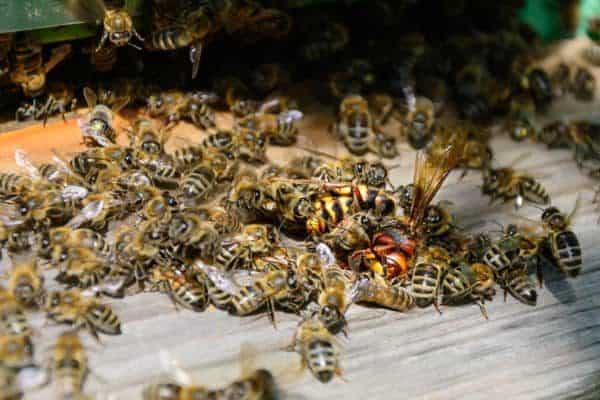
6. Protecting The Proboscis
A proboscis is a long elastic multi-piece tongue prone to damage. The mandibles act as a sheath to protect and support the tongue when not in use. It is folded into a section inside the bee’s head, the mandibles then close over it and cover it completely.
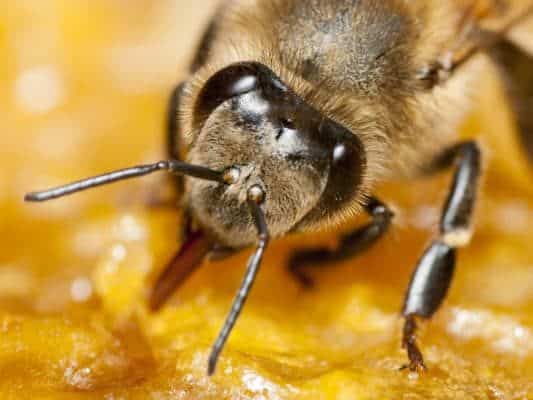
7. Collecting Resin And Making Propolis
The worker bees harvest resin from plants using her mandibles. She then adds some secretions from the saliva and works on the resin, until it is pliable, then stores it on pollen baskets.
On arrival at the hive, another worker bee uses her mandible to offload the harvest. The propolis is still chewed further before it can be used. When ready to use, the workers still use the mandibles to apply and spread it where it is needed.
8. Sleeping
This one is funny! When out at night, many male bees from various species hold on to leaves or stems with their mandibles and then fall asleep. It is not a wonder to see groups of male bees hanging by their jaws and soaked in dew.
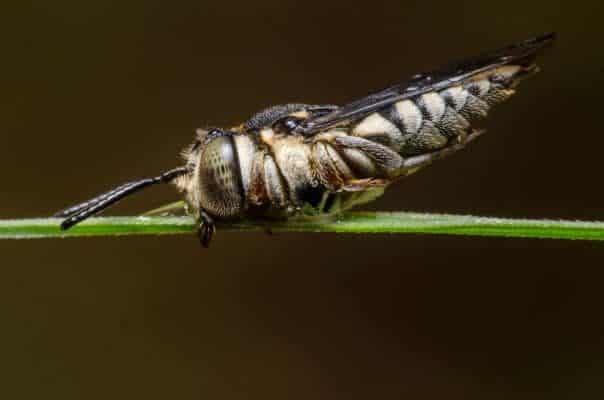
9. Grooming and Cleaning the Hive
The worker bees remove any debris or trash from the hive by using the mandibles. These may include wood chips, dead bees or other insects, pieces of paper, and the like. They also use the mandibles to groom themselves and the queen.
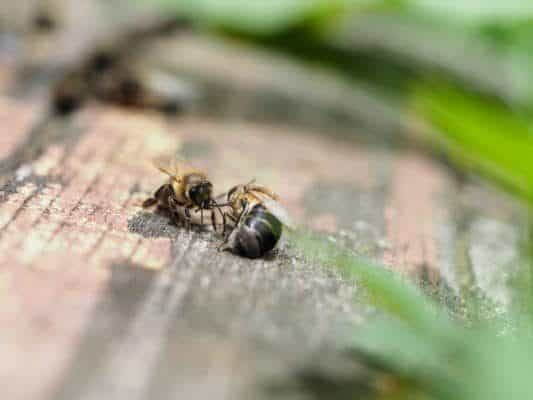
The Wrap Up
The value of mandibles in a bee is priceless. They need teeth to survive and perform the majority of their tasks. The shape, size, or number of teeth depends on the duties a bee is supposed to accomplish in its short life. Stingless bees use their teeth as a primary tool of defense while others resort to biting only when the predators are too small to bite.
Sources
https://www.bbc.com/news/technology-20080389
https://americanbeejournal.com/the-marvel-of-mandibles/
https://msu.edu/course/ent/410/snapshot.afs/bees/fs03/ch2/head.html
https://journals.plos.org/plosone/article?id=10.1371/journal.pone.0047432
https://www.newscientist.com/article/dn26562-zoologger-stingless-suicidal-bees-bite-until-they-die/
